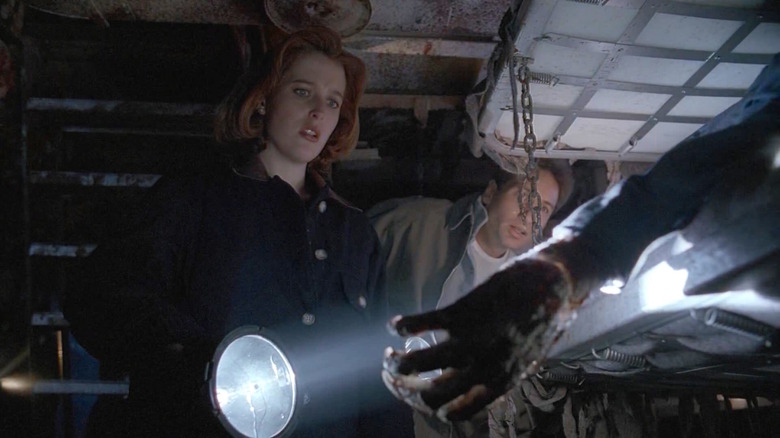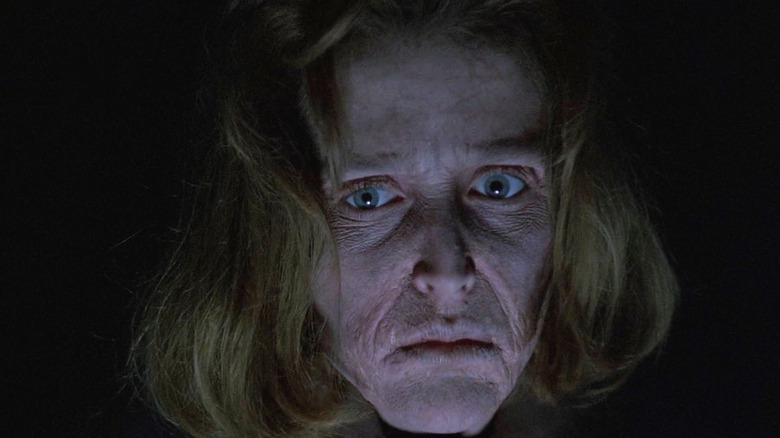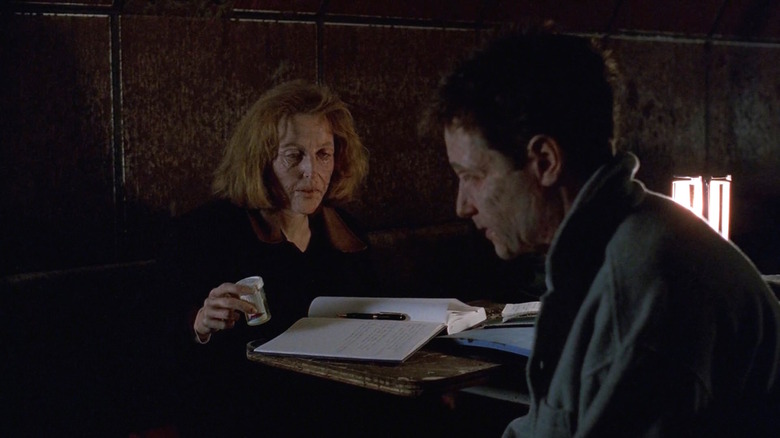The Chilling X-Files Episode Inspired By A U.S. Navy Conspiracy Theory
Inthe 1995 "The X-Files" episode "Død Kalm," Agents Mulder and Scully (David Duchovny and Gillian Anderson) trek out to the U.S.S. Ardent, an American destroyer frozen in a remote area off the coast of Norway. The ship had recently been abandoned by its crew as a mysterious environmental condition had caused them to age rapidly; although in their 20s, they looked like they were in their mid-60s. When Mulder and Scully arrive on the Ardent, they find that the remaining crew on board has become mummified and that the ship's hull has already begun to rust through. Before too long, Mulder and Scully begin aging rapidly as well. Mulder theorizes that they have encountered a "wrinkle in time," and that the Ardent might be going through something similar to the notorious Philadelphia Experiment of 1943. Scully later finds that their advanced aging might have something to do with the ship's freshwater supply.
Fans of conspiracies (that is the fun kind of conspiracies that involve aliens and Mothmen, not the insane QAnon nonsense) may likely already be familiar with the Philadelphia Experiment. In 1943, a merchant marine named Carl M. Allen accidentally witnessed a bizarre, top-secret naval experiment wherein the Navy made an entire ship, the U.S.S. Eldridge, vanish from the Philadelphia Naval Shipyard. Was the Navy trying to make ships invisible? The generally accepted theory is that the Navy had invented a cloaking device like on "Star Trek," and the Eldridge was one of the vessels they tested it on.
The connections between "Død Kalm" and the Philadelphia Experiment are only tenuous, and advanced aging isn't part of the original conspiracy theory, but Mulder does mention it by name.
The true story — passed through hearsay — is even more bizarre.
The Philadelphia Experiment
The story goes that in 1955, Allen read a copy of Morris K. Jessup's book "The Case for the UFO: Unidentified Flying Object," a case study on real-life UFO encounters. Allen evidently wrote notes in the margins of the book, referring to multiple people he had been talking with (one was named "Jemi") about alien propulsion technologies. The notes alleged that Jessup was really close to discovering the truth about aliens. The notes also talked about various alien species that had come into contact with humans.
Some of the notes alluded to the disappearing ship back in 1943, when Allen was stationed on board the S.S. Andrew Furuseth. Allen says he witnessed the Eldridge disappear for several moments before reappearing. He alleged that the ship had not merely turned invisible, but was temporarily teleported to Norfolk, Virginia. The part of Allen's papers that bears the closest resemblance to "Død Kalm" was the claim that the sailors on board the Eldridge began suffering from eerie side effects after having been teleported. Some of them, he said, had become frozen in time, while others remained slightly "faded" out of reality.
Allen mailed his marked-up copy of Jessup's book to the Office of Naval Research. In 1957, Jessup was invited to look at the book, and he recognized the handwriting. It seems he had been getting UFO-related letters for years from a man named "Carlos Miguel Allende," alleging similar things as the notes in his book. Allende was an alias adopted by Allen. It seems obvious now, right?
The book might have been dismissed, but a nascent mimeographic company started making copies, and the conspiracy began to proliferate. Prior to mimeographing, copies had to be re-typed or re-printed. Now, Allen's handwritten notes could be easily duplicated.
Was the X-Files account real?
The Philadelphia Experiment leaked its way into underground circles and eventually began bubbling up into the popular consciousness. Other UFO authors began to cite it as proof of alien technology and of a vast government conspiracy to cover it up. After all, if humans could teleport something as large as a ship, wouldn't that revolutionize travel forever? Charles Berlitz and William L. Moore authored a famous book in 1979 about the incident called "The Philadelphia Experiment: Project Invisibility." In 1984, director Stewart Raffill ("Mac and Me") adapted that book into a movie called "The Philadelphia Experiment" starring Nancy Allen and Michael Paré. By 1995, it was the backdrop for an episode of "The X-Files."
When the Navy was asked about the Philadelphia Experiment, they published a letter stating that it was categorically untrue. The letter read:
"Personnel at the Fourth Naval District believe that the questions surrounding the so-called 'Philadelphia Experiment' arise from quite routine research which occurred during World War II at the Philadelphia Naval Shipyard. Until recently, it was believed that the foundation for the apocryphal stories arose from degaussing experiments which have the effect of making a ship undetectable or 'invisible' to magnetic mines."
The letter also noted:
"Another likely genesis of the bizarre stories about levitation, teleportation and effects on human crew members might be attributed to experiments with the generating plant of a destroyer, the U.S.S. Timmerman. In the 1950's this ship was part of an experiment to test the effects of a small, high-frequency generator providing 1,000hz instead of the standard 400hz. The higher-frequency generator produced corona discharges, and other well-known phenomena associated with high-frequency generators. None of the crew suffered effects from the experiment."
As "The X-Files" might say, TRUST NO ONE, and DENY EVERYTHING.


